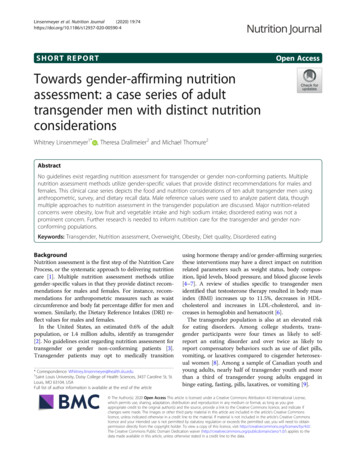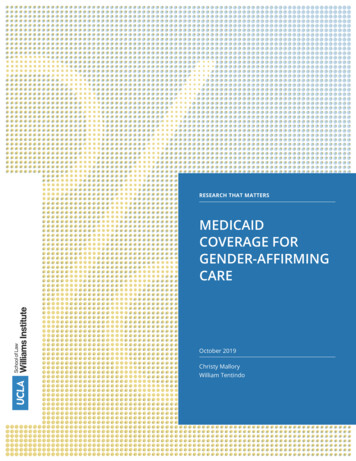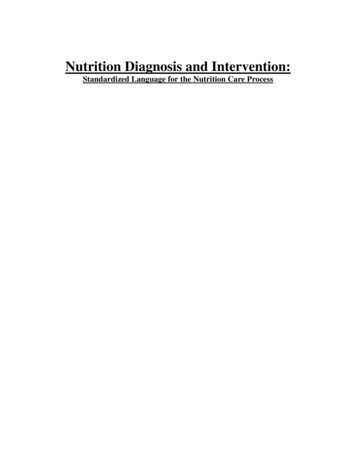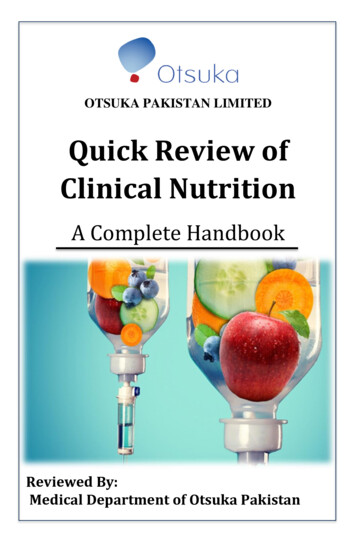
Transcription
Linsenmeyer et al. Nutrition Journal(2020) RT REPORTOpen AccessTowards gender-affirming nutritionassessment: a case series of adulttransgender men with distinct nutritionconsiderationsWhitney Linsenmeyer1* , Theresa Drallmeier2 and Michael Thomure2AbstractNo guidelines exist regarding nutrition assessment for transgender or gender non-conforming patients. Multiplenutrition assessment methods utilize gender-specific values that provide distinct recommendations for males andfemales. This clinical case series depicts the food and nutrition considerations of ten adult transgender men usinganthropometric, survey, and dietary recall data. Male reference values were used to analyze patient data, thoughmultiple approaches to nutrition assessment in the transgender population are discussed. Major nutrition-relatedconcerns were obesity, low fruit and vegetable intake and high sodium intake; disordered eating was not aprominent concern. Further research is needed to inform nutrition care for the transgender and gender nonconforming populations.Keywords: Transgender, Nutrition assessment, Overweight, Obesity, Diet quality, Disordered eatingBackgroundNutrition assessment is the first step of the Nutrition CareProcess, or the systematic approach to delivering nutritioncare [1]. Multiple nutrition assessment methods utilizegender-specific values in that they provide distinct recommendations for males and females. For instance, recommendations for anthropometric measures such as waistcircumference and body fat percentage differ for men andwomen. Similarly, the Dietary Reference Intakes (DRI) reflect values for males and females.In the United States, an estimated 0.6% of the adultpopulation, or 1.4 million adults, identify as transgender[2]. No guidelines exist regarding nutrition assessment fortransgender or gender non-conforming patients [3].Transgender patients may opt to medically transition* Correspondence: Whitney.linsenmeyer@health.slu.edu1Saint Louis University, Doisy College of Health Sciences, 3437 Caroline St, St.Louis, MO 63104, USAFull list of author information is available at the end of the articleusing hormone therapy and/or gender-affirming surgeries;these interventions may have a direct impact on nutritionrelated parameters such as weight status, body composition, lipid levels, blood pressure, and blood glucose levels[4–7]. A review of studies specific to transgender menidentified that testosterone therapy resulted in body massindex (BMI) increases up to 11.5%, decreases in HDLcholesterol and increases in LDL-cholesterol, and increases in hemoglobin and hematocrit [6].The transgender population is also at an elevated riskfor eating disorders. Among college students, transgender participants were four times as likely to selfreport an eating disorder and over twice as likely toreport compensatory behaviors such as use of diet pills,vomiting, or laxatives compared to cisgender heterosexual women [8]. Among a sample of Canadian youth andyoung adults, nearly half of transgender youth and morethan a third of transgender young adults engaged inbinge eating, fasting, pills, laxatives, or vomiting [9]. The Author(s). 2020 Open Access This article is licensed under a Creative Commons Attribution 4.0 International License,which permits use, sharing, adaptation, distribution and reproduction in any medium or format, as long as you giveappropriate credit to the original author(s) and the source, provide a link to the Creative Commons licence, and indicate ifchanges were made. The images or other third party material in this article are included in the article's Creative Commonslicence, unless indicated otherwise in a credit line to the material. If material is not included in the article's Creative Commonslicence and your intended use is not permitted by statutory regulation or exceeds the permitted use, you will need to obtainpermission directly from the copyright holder. To view a copy of this licence, visit http://creativecommons.org/licenses/by/4.0/.The Creative Commons Public Domain Dedication waiver ) applies to thedata made available in this article, unless otherwise stated in a credit line to the data.
Linsenmeyer et al. Nutrition Journal(2020) 19:74Ultimately, nutrition therapy may play an importantrole in mitigating the known effects of hormone therapyand promoting the overall health of transgender andgender non-conforming populations. Given the lack ofnutrition recommendations for the transgender population, nutrition assessment of both clinical and psychosocial considerations is the first step towards forming aframework of gender-affirming care across the NutritionCare Process.MethodsDesignThe purpose of this case series was to depict the food andnutrition considerations of adult transgender men. Tenparticipants were recruited using direct mail and word-ofmouth. Participants were at least 18 years of age and identified as transgender male or transmasculine, and may ormay not have pursued gender-affirming medical interventions such as hormone therapy or surgeries. Transfeminine and non-binary participants were excluded from thisstudy given that the researchers felt the nutrition considerations may be distinct enough to warrant separate studies focused on other gender identities. Participantsprovided written consent and were remunerated with anominal gift card. The Saint Louis University InstitutionalReview Board approved this study.Page 2 of 8compared to the Acceptable Macronutrient DistributionRanges (AMDR) for carbohydrates, fat and protein.Recommended Dietary Allowances (RDA) or AdequateIntake (AI) values were used for fiber, calcium, vitaminD, potassium, and iron needs. Percent intake values / 0–10% the Dietary Reference Intakes (DRI) were characterized as adequate; / 11–20% the DRI were characterized as marginally high or low; / 20% the DRIwere characterized as high or low.The Dietary Guidelines for Americans (DGAs) 2015–2020 were used as the reference recommendations for saturated fat ( 10% total kcals) and sodium ( 2300 mg/day).In the case presentations, saturated fat intake of 0–10% oftotal kcals was characterized as appropriate; 11–15% wascharacterized as marginally high; 15% was characterizedas high. For sodium, intake of 0–110% the recommendation was characterized as appropriate; 111–120% wascharacterized as marginally high; 120% was characterized as high.As depicted in Table 1, many of the data types aregender-specific in that they provide specific recommendations for males and females. The research team optedto utilize the male values given that the participantswere either receiving hormone therapy or intended todo so in the near future.Research teamData collection and analysisData collection occurred from October 2018 to February2019 and included anthropometric, survey, and dietaryrecall data. The reference source for each data type isexpressed in Table 1. Anthropometric data includedBMI, waist circumference, and body fat percentage. Survey data included two nutrition screeners related to disordered eating: the EAT-26 and ecSI-2. The EAT-26estimates eating disorder risk and has been validatedwith adolescent and adult populations; a score of 20/26or higher was the cutoff for high eating disorder risk[10]. The ecSI-2 measures eating competence, which ischaracterized by a positive, comfortable, and flexible approach to food, and has been validated with variousadult populations across income groups; a score of 32/48 or higher was the cutoff for high eating competence[11]. Data collection also included a patient interview;this data will be analyzed separately, but short segmentswere included in this case series in order to bettercontextualize the narrative of each case.A diet analysis of each participant was conductedusing a three-day food diary and the software ESHAFood Processor Nutrition Analysis. Energy needs tomaintain weight were calculated using the Estimated Energy Requirement (EER) formula, which accounts forheight, weight, age, activity level, and gender. The percentage of kcal intake from each macronutrient wasAn interdisciplinary clinical research team analyzed thedata individually for each case and identified trendsacross the ten cases. The team was comprised of a registered dietitian with a research focus on nutrition carefor the transgender population, a family physician whoprovides gender-affirming medical care for patients at acommunity health center, and a reproductive endocrinologist who provides gender-affirming medical care forpatients at an area hospital. The research team was selected given their content expertise in medicine anddietetics, as well as their activity in both research anddirect patient care with the transgender population.Case presentationsThe following cases are presented in order of age fromyoungest to oldest. Coded initials are used to ensureconfidentiality. The results are depicted in Table 2.Case 1BN is a 22 year-old transgender male and was just aboutto start hormone therapy. He works night shifts andnotes, “I just don’t eat what I should.” BN is hopeful thathis diet and exercise will improve moving forward andthat “testosterone’s going to help weight distribution andthings like that.”BN has a BMI of 45 kg/m2, body fat percentage of 40%and waist circumference of 56 in., indicating class III
Linsenmeyer et al. Nutrition Journal(2020) 19:74Page 3 of 8obesity and central adiposity. He has a low risk of eatingdisorders (5/26 on the EAT-26) and yet a low degree ofeating competence (16/48 on the ecSI-2). His dietarypattern includes 3–4 eating instances per day at home,work, or fast food restaurants. BN consumes 0–1 servings of fruits and vegetables per day and has a high intake of added sugars in the form of sodas, sweetened tea,and ice cream.BN’s diet analysis was characterized by low energy(59% kcal needs), appropriate saturated fat (10% kcal intake), low fiber (45% AI) and high sodium (149% DGAslimit). His macronutrient intake was 48% carbohydrate,37% fat and 15% protein, or within recommendedAMDR ranges. BN’s micronutrient intake reflect low calcium (40% RDA), vitamin D (3% RDA), potassium (36%AI) and marginally high iron intake (114% RDA).II and central adiposity. He has a low risk of eating disorders (16/26 on the EAT-26) and yet a low degree ofeating competence (30/48 on the ecSI-2). His dietarypattern includes 4–5 eating instances per day at homeand fast food restaurants. VK consumes 2–3 servings offruits and vegetables daily and added sugars in the formof sweetened coffee drinks and energy bars.VK’s diet analysis was characterized by low energy(58% kcal needs), high saturated fat (29% kcal intake),low fiber (32% AI), and marginally high sodium (117%DGAs limit). His macronutrient intake was 21% carbohydrate, 55% fat and 24% protein, or lower in carbohydrate and higher in fat than the AMDR ranges. VK’smicronutrient intake reflected high calcium (124%RDA), low vitamin D (7% RDA), low potassium (16%AI) and adequate iron (102% RDA).Case 2Case 4CE is a 27 year-old transgender male. He gained 40 lbs.when starting hormone therapy 18 months ago. CE reported that he “tried really hard for like, about 6-8months to lose it, and then I was getting nowhere. So, Ijust kind of gave up.” He also described himself as apicky eater and “weird about textures,” but that he isstarting to try new foods that his boyfriend prepares.He has a BMI of 33 kg/m2, body fat percentage of 34%and waist circumference of 41 in., indicating obesity classI and central adiposity. He has a low risk of eating disorders (6/26 on the EAT-26) and yet a low degree of eating competence (24/48 on the ecSI-2). CE’s dietarypattern includes 2–4 eating instances per day at homeand work. He consumes 0–1 servings of vegetables perday and a high intake of added sugars in the form ofsodas, iced coffees and energy drinks.His diet analysis was characterized by low energy (74%kcal needs), appropriate saturated fat intake (10% kcalintake), low fiber (41% AI), and high sodium (206%DGAs limit). His macronutrient intake was 63% carbohydrate, 23% fat and 14% protein, or within recommended AMDR ranges. CE’s micronutrient intakereflected adequate calcium (105% RDA), low vitamin D(48% RDA), low potassium (40% AI), and marginally lowiron (84% RDA).MR is a 30 year-old transgender male and has been onhormone therapy for just over 1 year. He reported gaining 15 lbs. of mostly muscle mass during the first 2months of hormone therapy and then losing weight aftera reconstructive chest surgery, or top surgery. He notes,“I don’t necessarily want to be thinner.” MR is somewhatconscientious of his kcal intake but is primarily drivenby the feeling: “I still want to have a lot of fun, and Iwant to be myself.”He has a BMI of 25 kg/m2, body fat percentage of 19%and waist circumference of 32 in., indicating an overweight BMI and yet overall healthy body weight andcomposition given the additional anthropometric measures. He has a low risk of eating disorders (3/26 on theEAT-26) and yet a low degree of eating competence (29/48 on the ecSI-2). MR’s follows a mostly vegetarian dietary pattern with 3–4 eating instances per day at homeand at restaurants. He consumes 2–3 servings of vegetables and fruits daily, very little added sugars, and 1–4 alcoholic drinks/day.MR’s diet analysis was characterized by marginally lowenergy (84% kcal needs), appropriate saturated fat (8%total kcals), low fiber (71% AI), and high sodium (134%DGAs limit). His macronutrient intake was 32% carbohydrate, 33% fat, and 22% protein, or lower in carbohydrate than the AMDR ranges. Additionally, 13% of hiskcals were derived from alcohol. MR’s micronutrient intake reflected high calcium (132% RDA), low vitamin D(53% RDA), low potassium (47% AI) and high iron intake (171% RDA).Case 3VK is a 29 year-old transgender male and has been onhormone therapy for 5 years. He noted that although hehas “always struggled with food and weight and bodyimage,” that his relationship with food and exercisestarted improving when he came out. He now approaches food as “more of a tool and a strengtheningthing.”VK has a BMI of 35 kg/m2, body fat percentage of 35%and waist circumference of 40 in., indicating obesity classCase 5CA is a 31 year-old transgender male. He started hormone therapy and had top surgery over 3 years ago. CAwas motivated to lose weight in order to be eligible fortop surgery, but didn’t feel comfortable going to the gym
Linsenmeyer et al. Nutrition Journal(2020) 19:74without wearing a binder, or a compression undershirtworn to flatten breasts, which he knew was not safe. CAalso had gastric sleeve surgery after his top surgery “justbecause I wanted to take care of my health more.” Henotes, “I feel like I made the right choice in doing topsurgery first, and then that lead me to take care of myself more.”CA has a BMI of 33 kg/m2, body fat percentage of 41%and waist circumference of 44 in., indicating class I obesity and central adiposity. He has a low risk of eating disorders (3/26 on the EAT-26) and yet a low degree ofeating competence (23/48 on the ecSI-2). He follows avegetarian dietary pattern with 5–6 eating instances perday at home and fast food restaurants. CA consumes 2–3 servings of fruits and vegetables daily and added sugarsin the form of breakfast cereals, muffins, and sweetenedtea.CA’s diet analysis was characterized by low energy(77% kcal needs), marginally high saturated fat (13%total kcals), low fiber (69% AI) and high sodium (154%DGAs limit). His macronutrient intake was 47% carbohydrate, 37% fat and 15% protein, or slightly higher infat than the AMDR ranges. CA’s micronutrient intakereflected adequate calcium (90% RDA), low vitamin D(11% RDA), low potassium (15% AI) and high iron(199% RDA).Case 6GT is a 32 year-old transgender male. He has been onhormone therapy for over 10 years and recalls initiallygaining approximately 40 lbs., which he lost slowly overtime. GT and his partner are now into ayurvedic cooking, though he still enjoys “going to get a burger acrossthe street.” GT is physically active with drumming, biking and rock climbing.He has a BMI of 25 kg/m2, body fat percentage of 15%and waist circumference of 35 in., indicating an overweight BMI and yet overall healthy body weight and composition given the additional anthropometric measures.He has a low risk of eating disorders (2/26 on the EAT26) and yet a low degree of eating competence (30/48 onthe ecSI-2). GT’s dietary pattern includes 5–7 eating instances per day at home, a friend’s home, or restaurants.He consumes 3–6 servings of fruits and vegetables dailyand sugar-sweetened foods and beverages in the form ofcoffee drinks, cookies and candy. His beverage intake alsoincludes 0–4 alcoholic drinks per day.GT’s diet analysis was characterized by marginally highenergy (119% kcal needs), marginally high saturated fat(14% total kcals), low fiber (59% AI) and high sodium(221% DGAs limit). His macronutrient intake was 43%carbohydrate, 36% fat and 16% protein, or slightly lowerin carbohydrate and higher in fat than the AMDRranges. Additionally, 5% of his kcals were derived fromPage 4 of 8alcohol. GT’s micronutrient intake reflected adequatecalcium (98% RDA), low vitamin D (3% RDA), marginally low potassium (89% DI) and high iron (263% RDA).Case 7CM is a 33 year-old transgender male and has been onhormone therapy for over 5 years. He experienced aninitial weight gain of approximately 60 lbs., both due toan increase in appetite and a genuine desire to have alarger body size. He describes this as, “I’m not going toblow over and am just more rugged, solid, stocky.”CM has a BMI of 51 kg/m2, body fat percentage of46% and waist circumference of 57 in., indicating classIII obesity and central adiposity. He has a low risk ofeating disorders (12/26 on the EAT-26) and a high degree of eating competence (35/48 on the ecSI-2). CM’sdietary pattern includes 5–6 eating instances per day athome, work, or fast food restaurants. He consumes 1–2servings of vegetables per day and added sugars in theform of candy, energy drinks, and ice cream. His beverage intake also includes 0–2 alcoholic drinks per day.CM’s diet analysis was characterized by adequate energy (102% kcal needs), marginally high saturated fat(14% total kcals), low fiber (71% AI) and high sodium(228% DGAs limit). His macronutrient intake was 42%carbohydrate, 41% fat and 15% protein, or lower incarbohydrate and higher in fat than the AMDR ranges.Additionally, 2% of his kcals were derived from alcohol.CM’s micronutrient intake reflected high calcium (167%RDA), low vitamin D (11% RDA), low potassium (37%AI) and high iron (149% RDA).Case 8SB is a 37 year-old transgender male and has been onhormone therapy for just over 1 year. He was highly motivated to improve his diet prior to starting hormonetherapy. He noted, “ the things I was able to eat, in mymind, were helping me to get ready for the medical transition.” He had also sought out foods that had been purported to increase natural levels of testosterone, thoughhe noted he doesn’t know if they actually worked or simply helped him to feel more mentally prepared.SB has a BMI of 21 kg/m2, body fat percentage of 13%and waist circumference of 31 in., indicating a healthybody weight and body composition. He has a low risk ofeating disorders (7/26 on the EAT-26) and a high degreeof eating competence (48/48 on the ecSI-2). SB follows agluten-free dietary pattern with 4–7 eating instances perday at home or work. He consumes 2–4 servings offruits and vegetables per day and minimal added sugarsin any form.SB’s diet analysis was characterized by adequate energy(109% kcal needs), appropriate saturated fat (7% totalkcals), low fiber (75% AI) and high sodium (169% DGAs
Linsenmeyer et al. Nutrition Journal(2020) 19:74limit). His macronutrient intake was 44% carbohydrate,38% fat and 18% protein, or slightly lower in carbohydrate and higher in fat than the AMDR ranges. SB’smicronutrient intake reflected low calcium (53% RDA),low vitamin D (20% RDA), low potassium (39% AI) andhigh iron (197% RDA).Case 9CJ is a 49 year-old transgender male and has been onhormone therapy for over 11 years. CJ’s diet or physicalactivity level has not changed over the years in relationto his transition. He comments, “I don’t think transitioning has changed anything about the way I eat, really.”Rather, his diet fluctuates more so in relation to his income and employment benefits.CJ has a BMI of 31 kg/m2, body fat percentage of 30%and waist circumference of 42 in., indicating obesity class Iand central adiposity. He has a low risk of eating disorders(2/26 on the EAT-26) and yet a low degree of eating competence (26/48 on the EAT-26). CJ’s dietary pattern includes 3–4 eating instances per day at home, restaurants,or in his car. He consumes 0–3 servings of fruits and vegetables per day and added sugars in the form of candy, pastries, cookies, and coffee drinks. His beverage intake alsoincludes low carbohydrate energy drinks.CJ’s diet analysis was characterized by marginally highenergy (112% kcal needs), high saturated fat (18% totalkcals), low fiber (49% AI) and high sodium (205% DGAslimit). His macronutrient intake was 38% carbohydrate,50% fat and 12% protein, or lower in carbohydrate andhigher in fat than the AMDR ranges. CJ’s micronutrientintake reflected marginally high calcium (111% RDA),low vitamin D (3% RDA), low potassium (18% AI) andhigh iron (158% RDA).Case 10GJ is a 51 year-old transgender male and has been onhormone therapy for 7 years. His diet has not changedmuch throughout his transition. He notes, “It’s prettymuch been the same throughout.” GJ points out thatmuch of the LGBT social community is centered aroundbars and that “you end up having a lot of calories of alcohol if you center around a bar, you know, your eating habits and drinking habits are not the greatest.”He has a BMI of 39 kg/m2, body fat percentage of 34%and waist circumference of 44 in., indicating obesity classII and central adiposity. He has a low risk of eating disorders (8/26 on the EAT-26) and yet a low degree of eating competence (23/48 on the EAT-26). GJ’s dietarypattern includes 3–4 eating instances per day. He consumes 0–2 servings of vegetables per day and sugarsweetened foods and beverages in the form of soda andcookies. His beverage intake also includes 0–3 alcoholicdrinks per day.Page 5 of 8GJ’s diet analysis was characterized by adequate energy(109% kcal needs), appropriate saturated fat (7% totalkcals), low fiber (39% AI) and high sodium (155% DGAslimit). GJ’s macronutrient intake was 64% carbohydrate,24% fat and 8% protein, or slightly lower in protein thanthe AMDR ranges. Additionally, 4% of his kcals were derived from alcohol. GJ’s micronutrient intake reflectedlow calcium (22% RDA), low vitamin D (0% RDA), lowpotassium (9% AI) and low iron (70% RDA).DiscussionBody weight and compositionAcross the 10 patients presented in this case series, 7(70%) were obese according to the Center for DiseaseControl (CDC) BMI standards. Three (30%) were obeseclass I, 2 (20%) were obese class II, and 2 (20%) wereobese class III [12]. Based on national survey data, 65.9%of transgender men are overweight or obese, and transgender males are the most likely to be obese across thelesbian, gay, bisexual, and transgender (LGBT) subgroups (46%) [13]. The findings of these case seriesreinforce existing assertions of obesity as a public healthconcern among the LGBT community and elevates theimportance for transgender men in particular.Weight gain and changes in fat distribution are knowneffects of both masculinizing and feminizing hormonetherapy. In a 2017 meta-analysis, transgender men experienced a net average weight gain of 3.7 lbs., with a lossin body fat and a gain in lean body mass [14]. However,multiple participants in this case series reported muchgreater weight gain; both TG and CE reported a 40 lb.weight gain, and CM gained 60 lbs. after starting hormone therapy. While hormone therapy may directly result in modest weight gain, overweight and obesity aremultifactorial conditions influenced by diet, lifestyle, andgenetic factors. The transgender community may be particularly vulnerable due to minority stressors and barriers to healthcare. It is also notable that patients maydesire a larger body size given their ideal masculine orfeminine body type, as was the case with CM. Furtherresearch is needed to explore weight management strategies that are both effective and culturally accepted bythe transgender community.Although two patients in this case series (MR and TG)were overweight by CDC standards, their body fat percentage and waist circumferences were within healthyranges. This suggests a higher degree of lean body massand therefore a mislabeling of overweight. Existingpopulation-level data on the transgender population utilizes BMI and does not include waist circumference orbody composition analyses for inherent logistical reasons. The findings of this case series suggests that sometransgender men may be mislabeled as overweight,which is an inherent limitation of BMI among all
Linsenmeyer et al. Nutrition Journal(2020) 19:74populations. In addition to the foundational work byKlaver et al., this is one of the first studies to includemeasures of body weight, body fat percentage, and waistcircumference to provide a more accurate description ofweight status [14, 15].Diet analysisParticipants reported a range of kcal intake from 58 to110% of their estimated needs. Variations may be due tounderreporting or alterations in food intake knowing thedata would be analyzed, or an intentional kcal deficit tosupport weight loss.None of the ten participants met the federal recommendations for fiber or fruit and vegetable intake, all ten reported a diet high or marginally high in sodium, and halfreported a diet high or marginally high in saturated fat.The average fiber intake among adults in the United Statesis 17 g per day; 87.1% of the population does not meet therecommendations for daily fiber intake [16]. Nationally,9.2% of men meet the federal fruit intake recommendations and 7.6% meet the federal vegetable intake recommendations [17]. An estimated 89% of adults consumeexcess sodium and 65% consume excess saturated fat [18,19]. Thus, the trends among participants in this study areconsistent with the existing estimates that most adults donot meet the federal recommendations for fiber, fruit andvegetable intake, sodium, or saturated fat.Regarding micronutrient intake, all participants reported diets low or marginally low in potassium, whichis likely second to the low intake of fruits and vegetables.Several participants reported diets high in calcium andiron, though the reported values did not approach theTolerable Upper Intake Levels (UL) for these minerals.Lastly, all participants reported diets low in vitamin D,though a more accurate assessment of vitamin D wouldaccount for endogenous synthesis from sun exposure. Incomparison, 91.5% of adult men in the United States areat risk for inadequate vitamin D intake from foods alone,26.0% for inadequate calcium intake, 35.0% for potassium intake, and 0.2% for inadequate iron intake [20].Regarding fast food, seven participants reported consuming fast food at least once during the 3 day reportingperiod. In comparison, 37% of U.S. adults consume fastfood on a given day [21]. Regarding alcohol, four participants in this case series reported alcohol consumptionon at least one of the 3 days. Though some exceeded themoderate alcohol intake recommendations, no participants quite met the threshold for binge drinking of fiveor more drinks on the same occasion [19]. In comparison, an average of 11.1% of men in the United Stateshave a mean alcohol intake that exceeds recommendations and 71.3% of men exceed the maximum recommendation for number of drinks on a given day [22].Page 6 of 8Gender-specific valuesAs depicted in Table 1, multiple nutrition assessmentmethods are gender-specific, meaning the referencesource indicates separate values for males and females.Within the anthropometric data collected, waist circumference and body fat percentage values were genderspecific. Within the diet analysis, total energy, fiber, calcium, vitamin D, potassium, and iron levels weregender-specific. This raises the logical question of howto approach nutrition assessment for transgender andgender non-conforming patients. No standards of careexist regarding nutrition assessment methods. Potentialapproaches are discussed below.Use values consistent with the patient’s gender identityClinicians may opt to utilize values consistent with thepatient’s gender identity. In this case series, we used thereference values for males across all data types. Thismay be a step towards gender-affirming nutrition assessment and may build rapport with patients. However, thisapproach may potentially misrepresent a patient’s nutrition status. For example, a patient with a waist circumference of 37 in. would be characterized as high for afemale ( 35 in.) but acceptable for a male ( 40 in.).Individualize assessment to align with the patient’s medicaltransitionAnother approach may be to individualize nutrition assessment to align as closely as possible with the patient’smedical transition, especially regarding the duration ofhormone therapy. This case series depicted a range ofpatient histories with regards to the initiation of hormone therapy. CJ had been on hormone therapy for over11 years, and BN was starting hormone therapy the verynext day.The World Professional Association for TransgenderHealth outlines the effects, expected onset, and expectedmaximum effect of both masculinizing and feminizinghormones with regards to body fat redistribution andchanges in muscle mass. For example, an increase inmuscle mass and strength has an expected onset of 6–12 months and an
Among college students, trans-gender participants were four times as likely to self-report an eating disorder and over twice as likely to report compensatory behaviors such as use of diet pills, . Doisy College of Health Sciences, 3437 Caroline St, St. Louis, MO 63104, USA










